
SS-Gefolge was the designation for the group of female civilian employees of the Schutzstaffel in Nazi Germany. SS-Gefolge members were only allowed to serve the Schutzstaffel in a very limited capacity as the organisation was not formally a part of the SS. Members of the Gefolge worked in the Nazi concentration camps as guards and nurses.[1]
Recruitment
During the early stages of the war the Gefolge was primarily staffed by volunteers, but as the war progressed on more women were either conscripted or recruited from wartime factories with the false promise of high pay and easier working conditions.[2]
Training
Virtually all of the Gefolge recruits were trained at Ravensbrück, trainees would have spent anywhere from one week to six months receiving instruction on disciplinary techniques, subterfuge detection, and escape prevention. Recruits were instructed to show no sympathy for their prisoners and any Gefolge member suspected of helping a prisoner was severely punished.[3]
In Concentration Camps
By mid-January 1945, around 3,500 women were said to have been on guard duty in the concentration camps, along with around 37,000 men. In general, based on the sparse literature on this subject, it is assumed that around 10% of the concentration camp guards were women. In addition to 8,000 SS men, about 200 female guards were on duty in the Auschwitz concentration camp between May 1940 and January 1945. SS Gefolge Women were the main Guards at female specific concentration camps of Ravensbrück, Auschwitz-Birkenau, Mauthausen, and Bergen-Belsen.[2] Male SS members were not permitted to enter the female camps.[4]
Notable members of the Gefolge
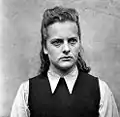 Irma Grese in August 1945
Irma Grese in August 1945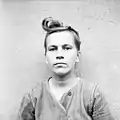 Elisabeth Volkenrath in August 1945
Elisabeth Volkenrath in August 1945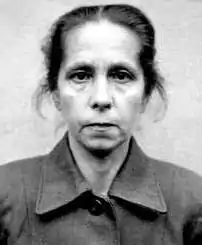 Johanna Bormann in August 1945
Johanna Bormann in August 1945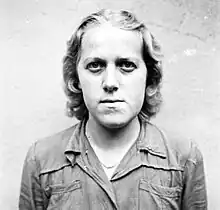 Hertha Bothe in August 1945
Hertha Bothe in August 1945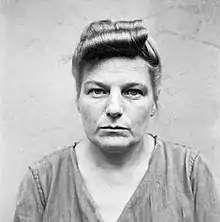 Hertha Ehlert in August 1945
Hertha Ehlert in August 1945
- Jenny Wanda Barkmann
- Elisabeth Becker
- Erna Beilhardt
- Erika Bergmann
- Jane Bernigau
- Dorothea Binz
- Grete Boesel
- Johanna Bormann
- Hertha Bothe
- Therese Brandl
- Hermine Braunsteiner-Ryan
- Luise Danz
- Margot Drechsel
- Hertha Ehlert
- Else Ehrich
- Irma Grese
- Martha Haake
- Wanda Klaff
- Liesbeth Krzok
- Hildegard Lächert
- Johanna Langefeld
- Elisabeth Lupka
- Maria Mandl
- Elisabeth Marschall
- Margarete Mewes
- Elfriede Mohneke
- Ruth Neudeck
- Alice Orlowski
- Ewa Paradies
- Margarete Rabe
- Gertrud Rabestein
- Elfriede Rinkel
- Ida Schreiter
- Gerda Steinhoff
- Maria Stromberger
- Inge Viermetz
- Elisabeth Volkenrath
- Erna Wallisch
- Emma Zimmer
Literature
- Simone Erpel (Hrsg.): Im Gefolge der SS: Aufseherinnen des Frauen-KZ Ravensbrück. Begleitband zur Ausstellung. Metropol Verlag, Berlin 2007, ISBN 978-3-938690-19-2.
- Ljiljana Heise: KZ-Aufseherinnen vor Gericht: Greta Bösel – “another of those brutal types of women”? Lang, Frankfurt am Main / Berlin / Bern / Wien 2009, ISBN 978-3-631-58465-1 (Zugleich Magisterarbeit an der FU Berlin 2007 unter dem Titel: Der erste Ravensbrück-Prozess (1946/47) und die Frage der Täterschaft von Frauen im Nationalsozialismus).
- Anette Kretzer: NS-Täterschaft und Geschlecht. Der erste britische Ravensbrück-Prozess 1946/47 in Hamburg. Metropol, Berlin 2009, ISBN 978-3-940938-17-6.
- Elissa Mailänder Koslov: Gewalt im Dienstalltag: Die SS-Aufseherinnen des Konzentrations- und Vernichtungslagers Majdanek 1942-1944. ISBN 3-86854-212-4, Dissertation, 520 Seiten mit 20 Abbildungen, Hamburger Edition, 2009. Interview mit der Autorin im Deutschlandfunk, Studiozeit, aus Kultur- und Sozialwissenschaften, Sendung vom 8. Oktober 2009.
- Jutta Mühlenberg: Das SS-Helferinnenkorps. Ausbildung, Einsatz und Entnazifizierung der weiblichen Angehörigen der Waffen-SS. Hamburger Edition, 2011, ISBN 978-3-86854-239-4.
- Silke Schäfer: Zum Selbstverständnis von Frauen im Konzentrationslager. Das Lager Ravensbrück. Berlin 2002 (Dissertation TU Berlin), urn:urn:nbn:de:kobv:83-opus-4303:{{{2}}}, doi:10.14279/depositonce-528.
- Claudia Taake: Angeklagt: SS-Frauen vor Gericht. Diplomarbeit an der Universität Oldenburg, Bis, Oldenburg 1998, ISBN 3-8142-0640-1.
- Jan Stetter: Täter und Täterinnen. Referat am historischen Seminar der Universität Hannover fundus.org (PDF; 43 kB; 6 Seiten)
- L. Heid: Die vergessenen Rädchen. Süddeutsche Zeitung, 17. Mai 2010.
References
- ↑ Schäfer, Silke (2002-10-21). "Zum Selbstverständnis von Frauen im Konzentrationslager" (in German). doi:10.14279/depositonce-528.
{{cite journal}}: Cite journal requires|journal=(help) - 1 2 Sofsky, Wolfgang (2013-06-17). The Order of Terror: The Concentration Camp. Princeton University Press. p. 109. ISBN 978-1-4008-2218-8.
- ↑ Baxter, Ian (2014). Belsen and it's Liberation : Rare photographs from Wartime Archives. Havertown: Pen and Sword. ISBN 978-1-4738-3930-4. OCLC 893732060.
- ↑ "Täter und Täterinnen (WK II) (Referat, Hausarbeit, Hausaufgabe)". 2008-03-27. Archived from the original on 27 March 2008. Retrieved 2022-05-04.